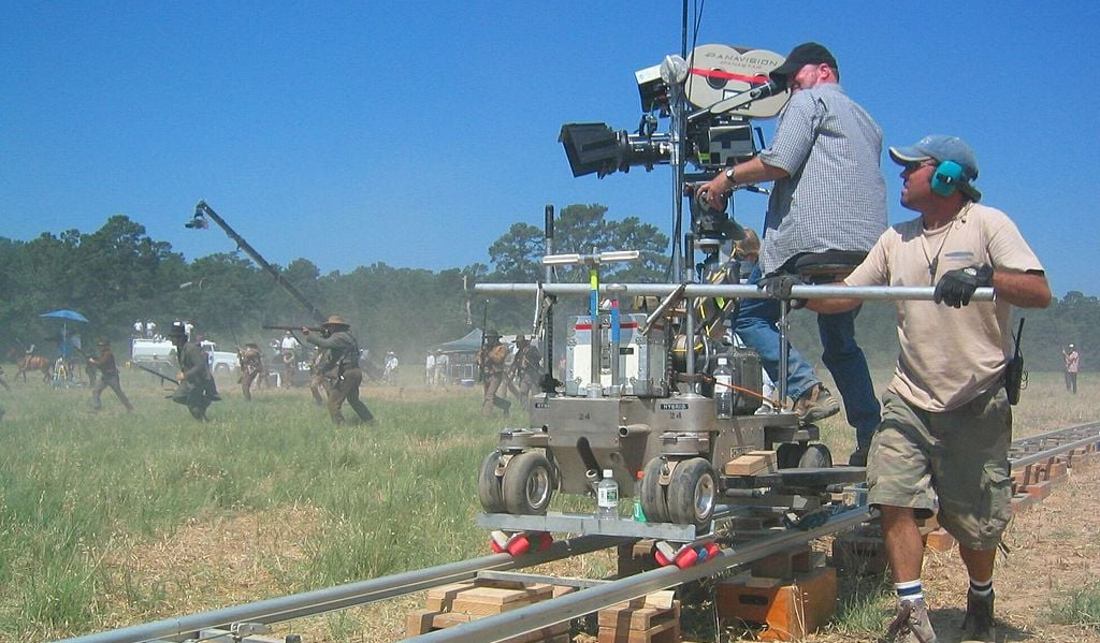Cinematographers, also known as directors of photography, work behind the scenes to capture every visual element necessary to bring a story to life. They work closely with directors to ensure their artistic vision is translated into truly compelling imagery. Using state-of-the-art cinematography equipment–as well as age-old techniques–they capture the perfect lighting, angles, and visual elements of every scene.
Cinematography Equipment
While not a complete list, here are some of the major pieces of cinematography equipment used in the film industry today. Some go back to the early days of filmmaking while others have been invented and improved throughout the ages.
Camera
What would a cinematographer be without a camera? Each camera offers capabilities that allow for specific visual styles and scope. Whether it’s the cinematic grandeur of the ARRI ALEXA or the portability of a GoPro, there are cameras out there that cater to all types of projects.
Digital cinema cameras are designed specifically for filmmaking and offer high-resolution image sensors, memory cards, and external hard drives–film is no longer needed. DSLR and mirrorless cameras are primarily known for still photography, but they also have video capabilities suitable for filmmaking as well.
Super 35mm and full-frame sensors use sensor sizes similar to traditional film formats, offering a cinematic look with shallow depth of field and excellent low-light performance. Drone cameras have become commonplace in the industry today, providing unique perspectives and sweeping views.
A few cinematographers still prefer the look and texture of film, and using 35mm and 16mm film cameras offer a distinct visual quality and are occasionally used for artistic or nostalgic reasons. Small rugged cameras such as the GoPro are ideal for capturing action sequences, sports footage, or shots in challenging environments.
Cinematography Equipment: Lenses
The use of lenses can greatly affect the overall appearance and story of the film. Cinematographers can achieve distinctive looks: from the wide-angle lens to the telephoto lens, each has its own unique characteristics that contribute to the visual storytelling of a film.
Prime lenses have a fixed focal length, meaning they cannot zoom in or out and are known for their optical quality, sharpness, and low distortion. Zoom lenses have adjustable focal lengths and provide flexibility in framing shots without changing the lens physically.
Wide-angle lenses have shorter focal lengths and capture a broader field of view. They are useful for expansive landscapes, establishing shots, and creating a sense of space and environment within a scene. Standard lenses have a field of view that resembles what the human eye sees.
Telephoto lenses are ideal for compressing distances, isolating subjects from the background, and capturing close-ups without getting physically close to the subject. Anamorphic lenses produce a unique widescreen aspect ratio by optically compressing the image horizontally.
Macro lenses, tilt-shift lenses, fisheye lenses, and others are used to skew the visuals in a specific way to bring a creative edge to a shot. Oftentimes, a cinematographer will use a viewfinder on the film set to establish a shot beforehand.
Lens Accessories
Beyond the (far from basic) basics of today’s filmmaking cameras, there are accessories that are still needed by the cinematographer. A follow-focus system, for example, allows the cinematographer or focus puller to precisely control the focus of the camera lens during a shot. Even a matte box can be attached to the front of the lens and help control light and prevent lens flares or glare.
Camera Movement Equipment
Obviously, the camera and lenses are pretty important pieces of cinematographer equipment, but they can be extremely heavy and require precision operation. Even smaller cameras need stability the human hand just can’t provide–unless a little jagged movement is required for the scene.
Fluid head tripods provide stability to the camera, ensuring smooth and steady shots when the camera is stationary. For more dynamic shots, cinematographers use stabilization systems like gimbals or steadicams. These devices keep the camera from shaking and allow for smooth movements while in motion.
When a scene calls for following movement over longer distances, a dolly and track are used to create smooth movements. This is a wheeled platform to move the camera horizontally or vertically along a track. Some cinematographers have even been known to use wheelchairs while holding the camera for this purpose.
Cranes or jibs are used to achieve hands-free sweeping and elevated camera movements (when drones aren’t available or something more steady is used). They offer a bird’s-eye view or dramatic overhead shots–boom poles can also be used.
Lighting Equipment
Just as important as the camera equipment, making sure the right lighting is available is crucial when natural light isn’t enough. Cinematographers use various filters to manipulate light and achieve specific visual effects. Common filters include ND filters (to control exposure), polarizers (to reduce reflections), and diffusion filters (to soften the image).
Cinematographers use various lights, including tungsten lights, LED panels, HMI lights, and fluorescent lights, to create the desired mood and atmosphere. From bright sunny days at the beach to dimly lit hallways, there’s a bulb for it. Light meters help cinematographers measure the intensity of light and ensure proper exposure.
Other equipment includes on-set monitors and video assist systems to review footage and ensure the desired image is being captured. And there are utilitarian tools of the trade too, such as walkie-talkies, gaffer tape, camera bags, and various input and output cables. And don’t forget extra batteries and chargers–running out of power should NEVER be a reason you have to stop shooting.
Depending on the scope of the project, cinematographers may also be part of the editing team during video production. Using Adobe Premiere Pro or Final Cut Pro, they’ll bring all of the different camera shots and audio recorder takes together, add effects, and make other changes needed by the director.
Get Hands-On Experience With Cinematographer Equipment at Film Connection
Want to learn more about cinematography for your filmmaking career? Film Connection puts you in the middle of the action, putting you on set or on location with a production studio so you can see how the equipment is used. As your skills improve, you will be able to take control of the camera, help set up lighting, and build your portfolio.
And you won’t have to take out massive student loans or spend years in a classroom. While theory is important, we’re firm believers that gaining experience in the field is more important than sitting at a desk. We’ll give you both in under nine months. Get started on your career today.





